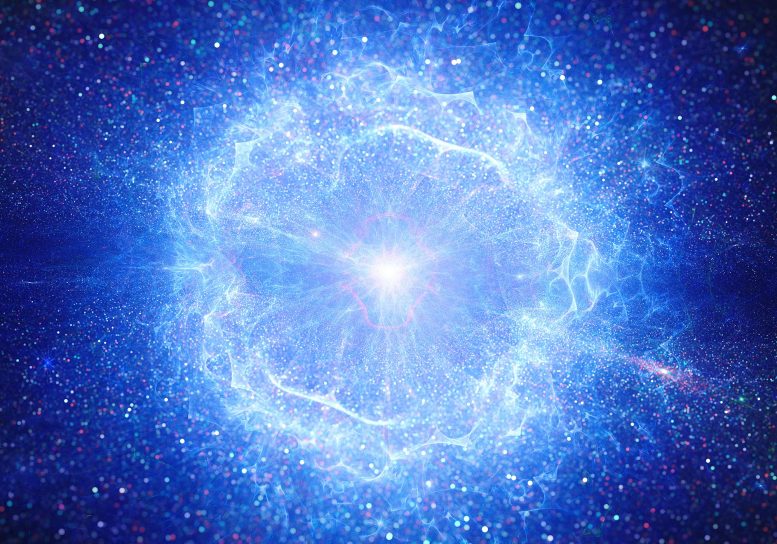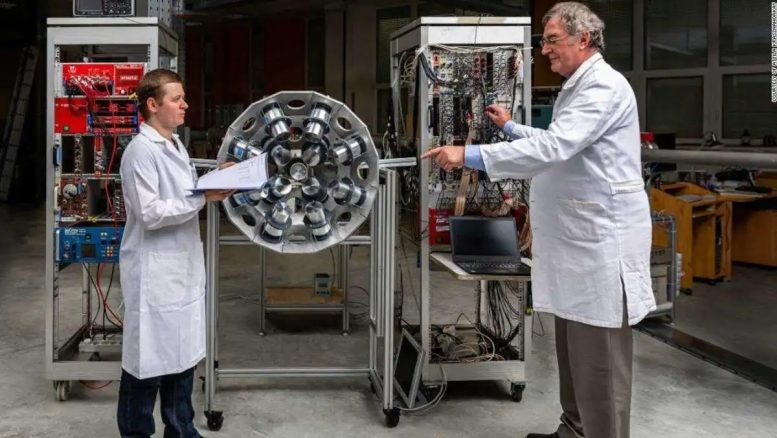
A team of scientists in Hungary recently published a paper that hints at the existence of a previously unknown subatomic particle. The team first reported finding traces of the particle in 2016, and they now report more traces in a different experiment.
If the results are confirmed, the so-called X17 particle could help to explain dark matter, the mysterious substance scientists believe accounts for more than 80% of the mass in the universe. It may be the carrier of a “fifth force” beyond the four accounted for in the standard model of physics (gravity, electromagnetism, the weak nuclear force, and the strong nuclear force).
Smashing atoms
Most researchers who hunt for new particles use enormous accelerators that smash subatomic particles together at high speed and look at what comes out of the explosion. The biggest of these accelerators is the Large Hadron Collider in Europe, where the Higgs boson – a particle scientists had been hunting for decades – was discovered in 2012.
Attila J. Krasznahorkay and his colleagues at ATOMKI (the Institute of Nuclear Research in Debrecen, Hungary) have taken a different approach, conducting smaller experiments that fire the subatomic particles called protons at the nuclei of different atoms.
In 2016, they looked at pairs of electrons and positrons (the antimatter version of electrons) produced when beryllium-8 nuclei went from a high-energy state to a low-energy state.
They found a deviation from what they expected to see when there was a large angle between the electrons and positrons. This anomaly could be best explained if the nucleus emitted an unknown particle which later “split” into an electron and a positron.

This particle would have to be a boson, which is the kind of particle that carries force, and its mass would be around 17 million electron volts. That’s about as heavy as 34 electrons, which is fairly lightweight for a particle like this. (The Higgs boson, for example, is more than 10,000 times heavier.)
Because of its mass, Krasznahorkay and his team called the hypothetical particle X17. Now they have observed some strange behavior in helium-4 nuclei which can also be explained by the presence of X17.
This latest anomaly is statistically significant – a seven sigma confidence level, which means there is only a very tiny possibility the result occurred by chance. This is well beyond the usual five-sigma standard for a new discovery, so the result would seem to suggest there is some new physics here.
Checking and double checking
However, the new announcement and the one in 2016 have been met with skepticism by the physics community – the kind of skepticism that did not exist when two teams simultaneously announced the discovery of the Higgs boson in 2012.
So why is it so hard for physicists to believe a new lightweight boson like this could exist?
First, experiments of this sort are difficult, and so is the analysis of the data. Signals can appear and disappear. Back in 2004, for example, the group in Debrecen found evidence they interpreted as the possible existence of an even lighter boson, but when they repeated the experiment the signal was gone.
Second, one needs to make sure the very existence of X17 is compatible with the results from other experiments. In this case, both the 2016 result with beryllium and the new result with helium can be explained by the existence of X17 but an independent check from an independent group is still necessary.
Krasznahorkay and his group first reported weak evidence (at a three-sigma level) for a new boson in 2012 at a workshop in Italy.
Since then the team has repeated the experiment using upgraded equipment and successfully reproduced the beryllium-8 results, which is reassuring, as are the new results in helium-4. These new results were presented at the HIAS 2019 symposium at the Australian National University in Canberra.
What does this have to do with dark matter?
Scientists believe that most of the matter in the universe is invisible to us. So-called dark matter would only interact with normal matter very weakly. We can infer that it exists from its gravitational effects on distant stars and galaxies, but it has never been detected in the lab.
So where does X17 come in?
In 2003, one of us (Boehm) showed that a particle like X17 could exist, in work co-authored with Pierre Fayet and alone. It would carry force between dark matter particles in much the same way photons, or particles of light, do for ordinary matter.
In one of the scenarios I proposed, lightweight dark matter particles could sometimes produce pairs of electrons and positrons in a way that is similar to what Krasznahorkay’s team has seen.
This scenario has led to many searches in low-energy experiments, which have ruled out a lot of possibilities. However, X17 has not yet been ruled out – in which case the Debrecen group might have indeed discovered how dark matter particles communicate with our world.
More evidence required
While the results from Debrecen are very interesting, the physics community will not be convinced a new particle has indeed been found until there is independent confirmation.
So we can expect many experiments around the world that are looking for a new lightweight boson to start hunting for evidence of X17 and its interaction with pairs of electrons and positrons.
If confirmation arrives, the next discovery might be the dark matter particles themselves.
Written by Celine Boehm, Head of School for Physics at University of Sydney and Tibor Kibedi, Senior Fellow in Nuclear Physics at Australian National University.
Adapted from an article originally published on The Conversation.![]()
Never miss a breakthrough: Join the SciTechDaily newsletter.
15 Comments
Regarding Dark Matter, there may be a String Theory explanation. As you may know, quantum mechanics requires that strings must be formed as pairs in the quantum foam – a string and an anti-string – that immediately annihilate each other. Quantum mechanics also requires both the string and anti-string to be surrounded by “jitters” that reduce their monstrous vibrating energies. What if this jitter remains for a fraction of an instant after their string/anti-string annihilations? This temporary jitter would be seen by us as matter for that instant before it too returns to the foam. That’s why we never see it – the “mass” lasts only for that instant but is repeated over and over and over, all over. Specifics on this can be found in my YouTube at https://www.youtube.com/watch?v=24WyRKT8t4w
And Santa is real.
yes he is, though, I call him father now. Do you know who your father is ?
hlo am new
hypothetical particle X17. They call the effect as imaginary particle that don’t exist. It could be energy form instead of particles. They didn’t bring any new discovery. When you call it matter it should carry characteristics not imaginary thoughts. Other can call it X17 energy.
A little surprised by some comments. I would have thought most people reading this article would have open minds. To those that don’t, step aside, the big kids are working.
exactly. The indignant arrogance of some of these posters. They are probably the failed grads, failed leads, who are now assistants, that sort of thing and bitter. Rather than build up, contribute and move forward, they tear down in futile childish attempts to uplift themselves. Probably why they are failed in their field to begin with.
blah blah blah
hotair hotair hotair
string theory? Please
Take me to your leader!!!
Very interesting stuff but….. will it blend?
Seems legit……
Carry On
Al Gore invented subatomic particles.
Well I was told many many years ago when I was in high school that matter cannot be created or destroyed. So I’ve been wondering ever since where did all the matter around us come from then?.
Merry Christmas
Cosmologists are clueless. The Universe is Electrical… 99 plus % of the universe is Plasma, plasma can be visible or not , but it is a different state of matter and behaves according to electrical laws not gravitational laws. And electromagnetism is 10-39th stronger than Gravity at 1.0. Most everything that the std theory find “surprising” or “unexpected” can be easily explained by electricity and electromagnetism.
Take a tour of Thunderbolts.info and open your eyes to a new paradigm.
Could dark matter be the virtual matter-antimatter particles created and instantly destroyed? You wouldn’t be able to see them, but since they are particles they have mass.